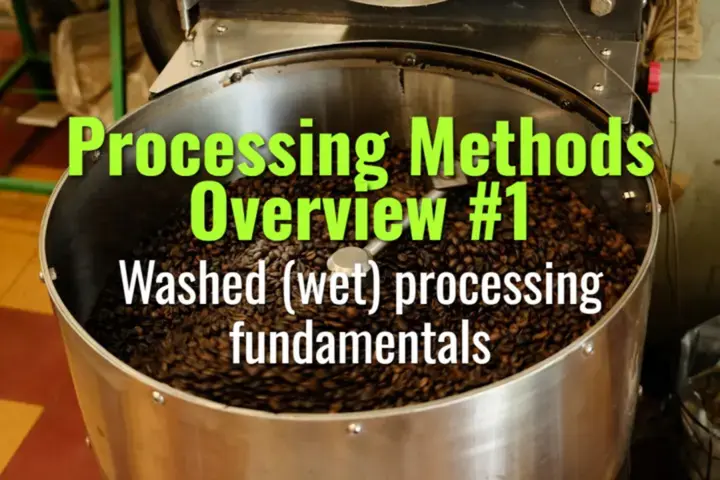Washed (wet) processing fundamentals
This topic explains the fundamentals of washed (wet) coffee processing, covering the main steps, advantages, challenges, and sensory outcomes of this widely used method.
- Coffee Basics Nerds
- 2 min read
Article 1 of 12 in Processing Methods Overview/

What is Washed Processing?
- Also called wet processing, it is the most common method for high-quality Arabica.
- Distinguishing feature: Fermentation and washing remove mucilage from beans before drying.
- Produces clean, bright, and consistent flavor profiles.
Key Steps in Washed Processing
1. Harvesting & Sorting
- Only ripe cherries selected (often hand-picked).
- Floats removed by density sorting (unripe/defective cherries float in water).
2. Pulping
- Outer skin and most pulp mechanically removed using a pulping machine.
3. Fermentation
- Beans, still coated in sticky mucilage, placed in fermentation tanks.
- Natural microbes break down mucilage.
- Duration: 12–72 hours depending on temperature, altitude, and tradition.
- Must be monitored to avoid over-fermentation (off-flavors).
4. Washing
- After fermentation, beans thoroughly washed in water channels or tanks to remove mucilage.
5. Drying
- Beans dried with parchment layer still on (to 10–12% moisture).
- Methods: Sun-drying on patios or raised beds, or mechanical dryers in wet climates.
Sensory Outcomes
- Clean, bright acidity.
- Distinct flavor clarity (citrus, floral, tea-like notes).
- Lighter body compared to natural/honey processed coffees.
- Preferred for specialty markets seeking transparency of origin and variety.
Advantages
- Produces consistent quality across lots.
- Highlights terroir and varietal differences.
- Reduces risk of fruity/fermented defects compared to natural processing.
Challenges
- Requires large amounts of water, raising sustainability concerns.
- Infrastructure-intensive (pulpers, fermentation tanks, washing channels).
- Wastewater must be treated to avoid pollution.
Regional Use
- Common in Latin America (Colombia, Central America), Africa (Kenya, Ethiopia), and parts of Asia.
- Many of the world’s most famous specialty coffees use washed processing.
Lasting Importance
Washed processing is the benchmark method for specialty-grade coffee. It enhances clarity, consistency, and terroir expression, but its water intensity and environmental footprint challenge producers to adopt more sustainable practices.
You might also like:
- Tags:
- Lasting Importance
- High Quality
- Specialty Markets
- Flavor Clarity
- Specialty Grade
- Latin America
- Raised Beds
- Flavor Profiles
- Natural Processing
- Lighter Body
- Central America
- Sensory Outcomes
- Challenges Requires
- Bright Acidity
- Terroir Expression
- Consistent Flavor
- Mechanical Dryers
- Washed Processing
- Consistent Quality
- Reduces Risk
- Clean Bright
- Grade Coffee
- Natural Honey
- Beans Dried
- Ripe Cherries
- Skin Pulp
- Fermentation Tanks
- Clarity Consistency
- Drying Beans
- Defective Cherries
- Environmental Footprint
- America Africa
- Washing Channels
- Processed Coffees
- Hours Depending
- Sticky Mucilage
- Sun Drying